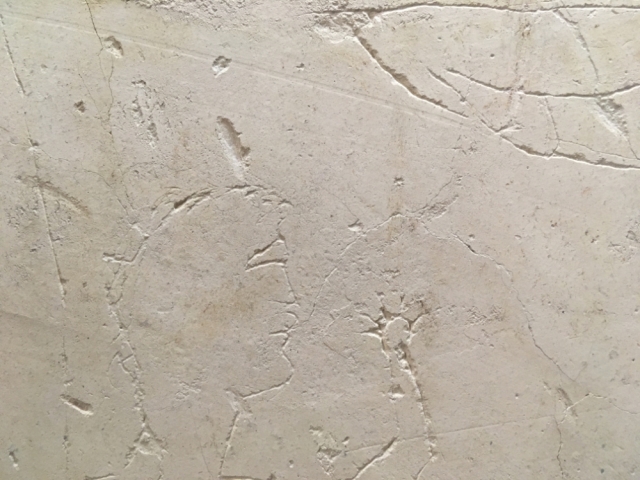Just about every introductory book on early Christianity will have an image, usually a drawing or a significantly enhanced photograph, of the famous “Alexamenos graffito,” a depiction of a man worshipping a crucified figure with the head of a donkey. The image, discovered in 1856 on the southwestern slope of the Palatine hill in Rome, is generally thought to evoke the experience of Christians in the Roman world in the age before Constantine. Usually assigned to some point in the third century, it is among the earliest depictions of the crucifixion of Jesus and a Christian worshipper.

Detail of the Palatine Alexamenos graffito (June 2018)

Image of the Palatine graffito of Alexamenos accompanying the discussion of Giulia Sacco,”Il graffito blasfemo del paedagogium nella Domus Augustana del Palatino,” in Ivan Di Stefano Manzella (ed.), Le iscrizioni dei cristiani in Vaticano (Vatican City, 1997), p. 192
Our views of the graffito are likely to be changed by some innovative work from Felicity Harley-McGowan that will be appearing soon. In the meantime, you may want to re-visit the artifact on the Palatine hill in Rome. The museum there that houses the graffito has undergone a major renovation. For much of the last fifteen years, the graffito has been placed fairly high up on a wall in a room with poor lighting, thwarting all my attempts to get decent photos. But now, the graffito has a new home at eye-level with nearly perfect lighting. (Be warned that you now must purchase a “S.U.P.E.R.” ticket to access the museum–€18! The old Palatine-Forum-Colosseum ticket no longer permits you to enter the Palatine Museum, the House of Augustus, and other areas that used to be part of general admission.) The graffito can now be easily studied and photographed in quite nice detail. The featured photo in this post is completely undoctored.
In addition, last week, the lower portion of the southwestern slopes of the Palatine reopened to visitors. The path through the area has been nicely landscaped with plants described by Pliny and other Roman authors. And one can now see the room in the paedagogium from which the graffito was removed after its discovery [Update 9 July 2018: A barrier now prevents entry into the room itself]. It’s very helpful for getting a sense of the space in which the graffito would have been displayed:

Palatine paedagogium, Room 7, view from the southwest, June 2018
There is still plaster on the walls, some of it with graffiti, but the area is not covered by a roof, so much of the plaster that was present several decades ago has now either worn away or has been purposely removed:

The graffiti from this area were formally published in 1966, and several of the items were illustrated with drawings. The graffiti that still remains in situ can be identified with these drawings when they exist, but it does appear that some material has been lost. Hopefully, other pieces aside from the Alexamenos graffito have been purposely removed and placed in storage.

In situ graffito from the southeast wall Room 7 of the paedagogium, edition of 1966 and in June 2018
The other portions of the Palatine that can be seen on the “S.U.P.E.R.” ticket are also quite impressive. There are areas of the House of Augustus, for instance, that have previously not been available to visitors that are now open (although you must endure an overly long light show and guided tour). But if you happen to be in Rome, I definitely recommend a visit.


From what I gather, you are going to wait until Dr. Harley-McGowan’s work comes out to give us any thoughts or socio-historical insight as to why the crucified figure is facing away from the artist, the choice of a donkey in comparison to other animals, or what the newest guess for when it was drawn was. I guess I will have to wait.
You’re really hiding your light under a bushel, Brent. Please join Twitter.
In the drawing, note that neither the clear horizontal for theta, nor the clear diagonal for nu has been highlighted ( = theon, “god,” not OEOII). Odd. Sometimes, too, earlier re-publications (like that once in BAR) have mistakingly offered the alternative interpretation that CEBETE could be the (plural!) imperative, “worship!” This is false. CEBETE can ONLY represent the orthographic variant CEBETAI (with AI = E), and hence the 3rd person singular, sc., “Alexamenos worships his God.” Future publications will, no doubt, no longer propagate this former error.
Pingback: A Marble Relief of a Priest of Cybele | Variant Readings
Pingback: Addenda to the Palatine Alexamenos Graffito | Variant Readings
Hi Brent,
you say paedagogium–but was there anything in the room itself on the plaster that identified it as such? In short: who is the artist? slave? elite boy? Palatine janitor? Can you recommend someone who gives the full context of the graffito? anything monograph length?
thanks!
Hi David, Thanks for the observation. The identification of the structure as a “paedagogium” is based on other graffiti found in the structure, namely a series of several examples in the form “Eutyches exi[t de pae]dacogio, Corinthus exit de pedacogio, etc.” It’s not clear what a paedagogium is in this context . Some inscriptions locate a paedagogium on the Caelian hill, but no inscriptions (to my knowledge) place such a structure on the Palatine. I don’t know of any monographs that deal with the question, though it is raised in Heikki Solin and Marja Itkonen-Kaila, Graffiti del Palatino, I. Paedagogium (Helsinki: Acta Instituti Romani Finlandiae, 1966). The person who knows the most about this now is probably Felicity Harley-McGowan.
Pingback: The Inscriptions of the Jewish Catacomb at Vigna Randanini | Variant Readings